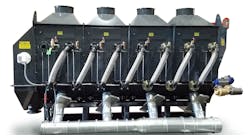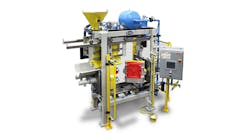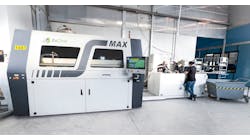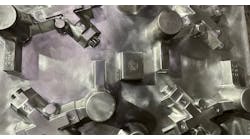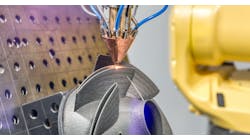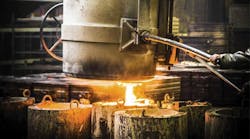Latest from Molds/Cores
Advances Show Progress, Potential for Inorganic Binder Systems
Surely you have heard it said that “Nothing is impossible!” That is an apt summary of the effects of recent developments in inorganic binder systems. However, there are still some lingering prejudices and doubts about this technology, and some of them are hard to break down. Among the common misconceptions are:
• Inorganic cores show a lower dimensional accuracy when casting, tend to have higher core fracture, and are unstable to moisture, and therefore cannot be coated with water; and,
• The waste sand cannot be regenerated, the casting surfaces show more sand accumulation, the cores have worse shakeout performance. and inorganics are not suitable for iron casting.
Some of these statements are incorrect, some of them are certainly essentially correct, and others are being disproved by new developments in inorganic binders. In addition, the following statement is also frequently encountered: "We really only want an inorganic cold-box system and nothing more!"
However, chemically speaking, they are worlds apart. By its very nature, chemistry sets specific limitations here that are hard to overcome. Even so – as recent developments in particular have shown – the new products are mainly aimed at closing the gap on traditional methods. Examples of how this has been achieved in several sectors, sometimes even exceeding expectations, are provided below.
It is well known that the requirements for casting surface quality are high. Foundries spend a great deal of time and money to meet the growing demands. In some cases, this also involves investment in secondary measures in blanks processing, for instance in blasting systems. Of course, the desire to eliminate many such measures is a factor here, but there is always something of a discrepancy between what is technically feasible, what is asked for, and what is viable in terms of cost.
Positive effects on casting surface quality are attributed to organic binders for two reasons: first, the resulting anthracite layer that forms a protective barrier between the casting and the core; and second, the resulting gas cushion that counters the metallostatic pressure, thus making it harder for the metal to penetrate the sand structure and for penetrations to occur.
Neither can be expected with inorganic binders, first because there are no combustion products, and second because the resulting gas volume (water + air) is much lower than with organic binder systems.
Therefore, it is clear that another approach must be found for inorganics in order to counter penetrations and sand accumulation. But what factors in the casting process actually have a positive or negative impact on penetrations (see Figure 1)?
New Approaches to Counter Penetration
One obvious factor is the casting temperature or the thermal energy that acts on the cores in the casting process, which is clearly indicated by the fact that more penetrations occur in the "hot spots" and in the gate region in particular. The casting pressure also shows a significant effect. For instance, in low-pressure permanent mold casting, a considerable impact on surface quality is observed if the casting pressure changes even slightly. There is often a very fine line between cold laps and penetration here.
To enable new solutions to be developed for series production in foundries, one thing is absolutely crucial: The problems and questions encountered in the foundry must be broken down to laboratory and technology-center scale in such a way that the casting errors to be rectified can be reconstructed or even caused.
In the case of optimization of penetrations, this was carried out with a gradual increase in the casting pressure until the casting result in the technology center matched that of the foundry. At this point, modification of the system was started, and the surface quality was gradually improved through evaluation of the casting results and corresponding optimization loops until the result shown in Figure 2 was attained.
Figure 3 shows how the mechanism of action that leads to this positive casting situation can be visualized. Components that reduce the wetting of the sand core surface by the metal are incorporated in the binder system. In addition, core compaction is increased by adding the new ingredients, thus making it harder for the metal to penetrate the gaps of the sand core surface. Together, the two effects lead to a considerable reduction in visible penetration on the casting.
By taking this mechanism of action into account, areas where reworking was previously essential can now be completed without processing (see Figure 4.)
In the past, removing the cores of castings produced using inorganic binders was often a challenge in the area of water jackets, especially if the core removal system had only a few degrees of freedom. At the same time, the requirements for the residual dirt content of components are becoming increasingly strict.
Therefore, one development objective should be to optimize existing systems with regard to their disintegration behavior after casting. Inserting predetermined breakage points in the binder bridges, which are not produced until the casting process, i.e. when thermal energy penetrates, improves the disintegration properties significantly, as Figure 5 shows clearly. With the INOTEC™ WJ 4000 promoter, complex and filigree water-jacket cores can be removed safely from the component again after casting (see Figure 5.)
Casting Complexity and Thin Walls
To achieve both increased engine output and low fuel consumption, one essential requirement for an inorganic binder system is an effective cooling concept for new cylinder heads and blocks. The resultant complexity and low wall thicknesses of the water jackets necessitate a high degree of thermal resistance during casting. Otherwise there is a risk of deformations, which lead to the scrapping of the component. For this reason, warm-box and Croning systems have been used with organic systems, especially with particularly critical deformation-prone water jacket cores as these systems have very high heat resistance. Inorganic systems can show plastic behavior without a corresponding modification in the casting temperature range of the aluminum and therefore have a tendency to deform. A rough description of this behavior is that the silicate softens like molten glass, thus becoming deformable under stress.
The difference between a system that is optimized in terms of thermal resistance and a system that has not been modified is shown in the hot-distortion measurement in Figure 6.
Whereas the non-optimized system has very fast bending, the heat-stable system has a much more "stable" characteristic curve. If a casting test is performed with both systems, the picture is also clear. When the thermally unstable system is used, clear differences in wall thickness are apparent, which suggests a massive amount of deformation during casting. By contrast, the thermally stable mixture produces a dimensionally accurate casting.
Heating microscopy is an extremely suitable method of examining the resistance of the binder systems. Here (see Figure 8), a rectangular test specimen of the material is put into a furnace and the softening and melting behavior is recorded in real time with a camera. The differences between the systems also are clearly apparent with this measuring method. In the case of the non-thermally optimized sample, softening is discernible at 778°C, whereas the more thermally stable mixture only loses its geometric rectangular shape at 1,310°C. In this way, systems can be assessed in terms of their thermal behavior and their effectiveness at preventing deformations.
Read Part 2 of Advances Show Progress, Potential for Inorganic Binder Systems
Each of the authors — Jens Mueller, global product line manager; Heinz Deters, head of laboratory; Martin Oberleiter, chemical-technical assistant; Henning Zupan, lab assistant; Hannes Lincke, manager, R&D; Ronja Resch, lab assistant; Joerg Koerschgen, manager, application technology; and Axel Kasperowski, manager, pilot foundry — is affiliated with ASK Chemicals GmbH in Hilden, Germany. Contact [email protected] or via phone. +49 211 711 030.




